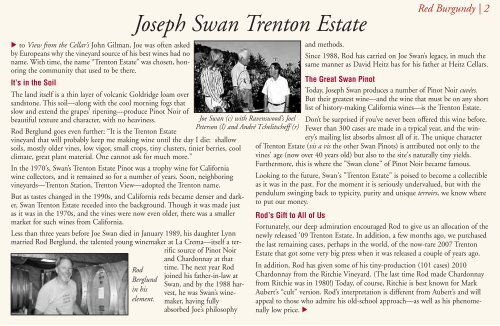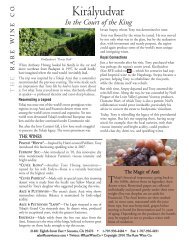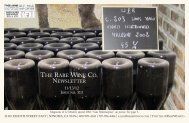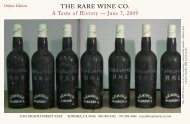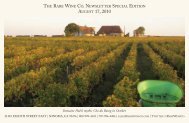Trenton Estate - Rare Wine Co.
Trenton Estate - Rare Wine Co.
Trenton Estate - Rare Wine Co.
Create successful ePaper yourself
Turn your PDF publications into a flip-book with our unique Google optimized e-Paper software.
Joseph Swan <strong>Trenton</strong> <strong>Estate</strong><br />
Red Burgundy | 2<br />
a to View from the Cellar’s John Gilman, Joe was often asked<br />
by Europeans why the vineyard source of his best wines had no<br />
name. With time, the name “<strong>Trenton</strong> <strong>Estate</strong>” was chosen, honoring<br />
the community that used to be there.<br />
It’s in the Soil<br />
The land itself is a thin layer of volcanic Goldridge loam over<br />
sandstone. This soil—along with the cool morning fogs that<br />
slow and extend the grapes’ ripening—produce Pinot Noir of<br />
beautiful texture and character, with no heaviness.<br />
Rod Berglund goes even further: “It is the <strong>Trenton</strong> <strong>Estate</strong><br />
vineyard that will probably keep me making wine until the day I die: shallow<br />
soils, mostly older vines, low vigor, small crops, tiny clusters, tinier berries, cool<br />
climate, great plant material. One cannot ask for much more.”<br />
In the 1970’s, Swan’s <strong>Trenton</strong> <strong>Estate</strong> Pinot was a trophy wine for California<br />
wine collectors, and it remained so for a number of years. Soon, neighboring<br />
vineyards—<strong>Trenton</strong> Station, <strong>Trenton</strong> View—adopted the <strong>Trenton</strong> name.<br />
But as tastes changed in the 1990s, and California reds became denser and darker,<br />
Swan <strong>Trenton</strong> <strong>Estate</strong> receded into the background. Though it was made just<br />
as it was in the 1970s, and the vines were now even older, there was a smaller<br />
market for such wines from California.<br />
Less than three years before Joe Swan died in January 1989, his daughter Lynn<br />
married Rod Berglund, the talented young winemaker at La Crema—itself a terrific<br />
source of Pinot Noir<br />
and Chardonnay at that<br />
Rod<br />
Berglund<br />
in his<br />
element.<br />
Joe Swan (c) with Ravenswood’s Joel<br />
Peterson (l) and André Tchelitscheff (r)<br />
time. The next year Rod<br />
joined his father-in-law at<br />
Swan, and by the 1988 harvest,<br />
he was Swan’s winemaker,<br />
having fully<br />
absorbed Joe’s philosophy<br />
and methods.<br />
Since 1988, Rod has carried on Joe Swan’s legacy, in much the<br />
same manner as David Heitz has for his father at Heitz Cellars.<br />
The Great Swan Pinot<br />
Today, Joseph Swan produces a number of Pinot Noir cuvées.<br />
But their greatest wine—and the wine that must be on any short<br />
list of history-making California wines—is the <strong>Trenton</strong> <strong>Estate</strong>.<br />
Don’t be surprised if you’ve never been offered this wine before.<br />
Fewer than 300 cases are made in a typical year, and the winery’s<br />
mailing list absorbs almost all of it. The unique character<br />
of <strong>Trenton</strong> <strong>Estate</strong> (vis a vis the other Swan Pinots) is attributed not only to the<br />
vines' age (now over 40 years old) but also to the site's naturally tiny yields.<br />
Furthermore, this is where the "Swan clone" of Pinot Noir became famous.<br />
Looking to the future, Swan's "<strong>Trenton</strong> <strong>Estate</strong>" is poised to become a collectible<br />
as it was in the past. For the moment it is seriously undervalued, but with the<br />
pendulum swinging back to typicity, purity and unique terroirs, we know where<br />
to put our money.<br />
Rod’s Gift to All of Us<br />
Fortunately, our deep admiration encouraged Rod to give us an allocation of the<br />
newly released '09 <strong>Trenton</strong> <strong>Estate</strong>. In addition, a few months ago, we purchased<br />
the last remaining cases, perhaps in the world, of the now-rare 2007 <strong>Trenton</strong><br />
<strong>Estate</strong> that got some very big press when it was released a couple of years ago.<br />
In addition, Rod has given some of his tiny-production (101 cases) 2010<br />
Chardonnay from the Ritchie Vineyard. (The last time Rod made Chardonnay<br />
from Ritchie was in 1980!) Today, of course, Ritchie is best known for Mark<br />
Aubert’s “cult” version. Rod’s interpretation is different from Aubert’s and will<br />
appeal to those who admire his old-school approach—as well as his phenomenally<br />
low price. a


